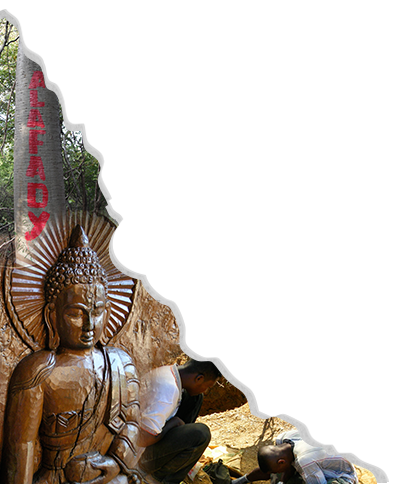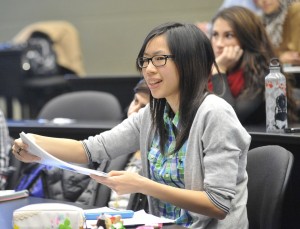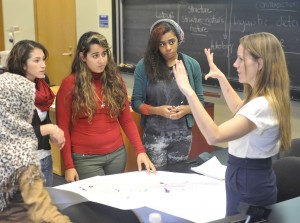
Part One: “My fieldwork isn’t about, like, anything!”
Ashley, an eager undergraduate student, arrived to my office exasperated. “My fieldwork isn’t about, like, anything! I must have, like, totally done it wrong.” Ashley had spent the afternoon observing interactions in the waiting room one of Toronto’s upscale tattoo parlours. Her visit was part of an assignment in my second-year linguistic anthropology course, “Culture and Communication.”
Introducing undergraduates to ethnographic methods and writing is a highlight of our discipline. My own migration from the sociology of education to anthropology came out of the intense connection I felt to the craft of ethnography after a short stint of participant-observation in a qualitative research methods course during my MA. Now converted, I can be evangelical about teaching culture experientially. Despite not teaching “methods” directly, I include field assignments in all of my courses. In a twelve-week term this is not without its challenges yet, for me, the results seem to outweigh obstacles.
Ashley surprised me with her choice to study tattooing. She was never without her pink jewel-encrusted cell phone, she showed up to every class with perfect hair and make-up, and had no visible tattoos. In allowing students to choose their field sites, I get a sense of what matters to them, and I am almost always surprised. I teach at three campuses at the University of Toronto and each, I have learned, have students with very different interests. For example, while my St. George (main campus) students are fascinated with either gentrification or race (or both), this past term at the west-end suburban campus, University of Toronto Mississauga (UTM), I had a group of over twenty women interested in online gaming, specifically World of Warcraft. I quickly re-organized their tutorial groups along lines of common interest (more on this later) to add content on the Ethnography of Virtual Worlds, an exciting new branch of the discipline.
I do, on occasion, veto student field choices. Some sites aren’t suited to getting at course themes and content, so re-routing them early is crucial. That said, including field-based papers means accepting that student work may stray from the course’s main aims. For example, in the fall I taught Political Ecology at the University of Toronto’s Scarborough (UTSC) campus. One of my students, Cassie, insisted on studying Whole Foods. I wasn’t sure this was ideal. She proved to be an exceptional observer and with work, she wrote a surprising investigation of the politics of gender and compassion in an upscale supermarket. While not traditionally a “Political Ecology” paper, it was illuminating and made use of theory we explored in the course. Like Ashley, Cassie came back after her first field visit unsure of herself and her choice. These low moments are among my favourites as a teacher. As a recent PhD they are all too familiar to me. The up side is that these precede the anthropological “AHA!” moment. While the AHA takes time and patience, teaching towards it makes my own writing process less painful.
Turning ethnographic data into text and argument is like turning lemons into sangria. Once the students have experimented with observational notes, and like Ashley, feel like they are doomed, I read the first section of Michael Taussig’s (2010) essay, The Corn-Wolf: Writing Apotropaic Texts:
Anthropology graduate student finishes two years of fieldwork and returns home with a computer full of notes and a trunk full of notebooks. Job now is to convert all that into a three-hundred-page piece of writing. No one has told her or him (1) how to do fieldwork or (2) that writing is usually the hardest part of the deal. Could these omissions be linked?
I mean—what a state of affairs! Here we have what are arguably the two most important aspects of anthropology and social science, and they are both rich, ripe secrets—secret-society-type shenanigans. Why so? Could it be that both are based on impossible-to-define talents, intuitions, tricks, and fears?
All the more reason to talk about them, you say.
Yes, but what sort of talk?
For is there not something else going on here, something connecting fieldwork to writingwork, something they have in common? For instance, fieldwork involves participant observation with people and events, being inside and outside, while writingwork involves magical projections through words into people and events. Can we say therefore that writingwork is a type of fieldwork and vice versa?
Reading this aloud two weeks before their papers are due substantially heightens their anxiety, making the imminent “AHA!” more elusive. I ask them to suspend fear and let things unfold as they may. I hold a one-day workshop devoted to reading and writing field notes together in small groups. Here baked goods and access to an inspiring setting are a big help. Once in “workshop” mode we can start to pull out directions for a paper and send them back to their sites with a more determined eye.
Ashley’s recorded interactions were not, of course, “about nothing.” We looked at her data and right away I was struck by the high frequency of what are called “echo utterances” in Conversation Analysis. This is essentially speech that repeats, in whole or part, what has just been said by another speaker. When speaking to female clients, the female tattoo artist repeated clients’ words and phrases to start almost all of her turns in the conversation. Ashley recalled that in class we had seen “echo utterances.” In her case, she noticed that they served to reinforce to the client that the artist understood client wishes, but also served as a strategy of what Bucholtz and Hall call “adequation”: seeking socially recognized sameness. The artist used specific conversation tactics to seem like the client. Likewise, in an appeal to “belong,” nervous clients picked up on the artist’s language. These observations opened up an avenue for Ashley to think about the linguistic labour involved in what is seemingly a “non-linguistic” act: getting a tattoo. Ashley went back to the shop determined to get more data on the kinds of strategies used to build rapport and to see if those were perhaps gendered. Her impending “AHA!” would be rewarding for us both.
Teaching how to see, read, and write culture is what keeps me in this business. Students’ anthropological “AHA!” moments are as satisfying as my own. If you aren’t of the “hands-on persuasion” then likely you are cynical about this. Maybe you teach a course on the Zombie Apocalypse or perhaps you teach huge introductory courses with reams of uninterested students trying to meet a breadth requirement. I have been there! Ok, not the zombie part, but I have seen this work in a variety of settings/courses. In the next post, I will show some variations on field-based assignments I have used.
Lindsay A. Bell is a recovering fourth-grade teacher now in the business of teaching Anthropology and Women and Gender Studies at the University of Toronto. In this two-part series, she shares her experiences in putting ethnographic methods and writing at the centre of undergraduate teaching. She teaches in the areas of linguistic anthropology, Indigenous issues, political ecology, gender, and consumer culture. She writes about anthropology, arctic studies, ashtanga yoga, and alliteration. You can find her on Twitter @DrLibertyBell.





